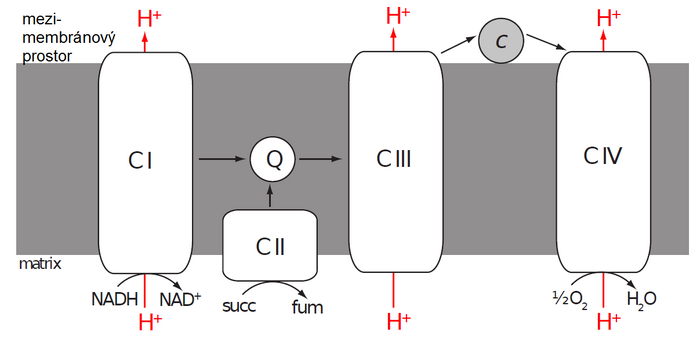Electron transport chain (FBLT)
Reduced cofactors coming from the cytoplasm (via a special transport system), as well as from reactions taking place in the matrix, are reoxidized on the inner mitochondrial membrane by a set of enzymes called the electron transport chain (ETC - electron transfer chain). It consists of four enzyme complexes referred to as Complex I–IV.
Complex I (NADH dehydrogenase)[edit | edit source]
- Complex I catalyzes the oxidation of NADH to NAD+ and at the same time the transfer of two electrons to coenzyme Q (CoQ) also called ubiquinone. The exact structure of mitochondrial Complex I is not completely known, but we know that it contains over 40 subunits, one FMN molecule and several iron atoms in complexes with sulfur (FeS clusters). Electrons released from NADH bind to FMN and subsequently jump from one FeS cluster to another until they reach ubiquinone and reduce it to ubiquinol.
- Ubichinol (CoQH2 or UQH2) is therefore a reduced form of ubiquinone (CoQ or UQ). The term coenzyme Q includes both forms. It is an extremely hydrophobic molecule, due to its long isoprenoid side chain, by which it is attached to the nonpolar core of the inner mitochondrial membrane. Here, CoQ functions as a mobile electron carrier from Complex I and II (or other enzymes) to Complex III.
Complex II[edit | edit source]
- Complex II catalyzes the oxidation of succinate to fumarateand is an integral part of the citrate cycle (succinate dehydrogenase). Electrons obtained by oxidation are first transported to FAD bound in the enzyme and subsequently via a chain of three FeS clusters and cytochrome b to ubiquinone.
Complex III (cytochrome c reductase)[edit | edit source]
- Complex III receives electrons from reduced CoQ' and passes them (via two cytochromes and FeS cluster) to another mobile electron carrier - cytochrome c. Cytochrome c is a small hemoprotein attached to the outer surface of the inner mitochondrial membrane. Unlike previous enzymes, one molecule of cytochrome c can transfer only one electron. There is a reduction of iron heme from ferri (III) to ferro (II) form. Thus, the electrons from ubiquinol are transferred one by one through a complex process called the Q-cycle.
Complex IV (cytochrome c oxidase)[edit | edit source]
- Complex IV, the last member of the ETC, takes the electrons from the reduced cytochrome c and passes them through two cytochromes and three copper atoms to the final recipient (acceptor), which is oxygen.

